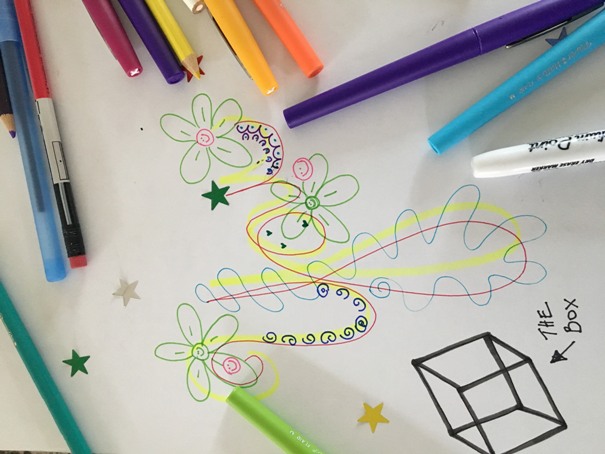
This article is my “yoga-ing outside the lines” permission slip for you.
It’s a metaphorical hall pass to tuck into your heart and take with you to class. It is my plea for you to be unabashedly willing to take care of yourself on all levels, in whatever classes you attend. It is my promise that you can trust yourself and get what you uniquely need. Show up a mess, or with your ducks in a row…just show up.
~
Yoga voice. We all know it. That calm, smooth, calculated voice with a predictable cadence that tells us to breathe, forget our troubles and let yoga sail us into serenity.
This way of speaking works for some students, but for me, I confess that it makes me feel disconnected from the instructor—as if we’re not of the same world. It’s definitely not the way I talk to people in my classes. My unwillingness to auto-zen my voice is just one way I teach yoga outside the lines.
Here are some confessions from 16 years of instructing and some ways you can scribble your way outside the perceived “lines” of yoga and create something better for yourself than what was already there.
1. Don’t always listen to the instructor.
What?! Yes. Sometimes—especially for those of us in physical pain or those who are slowly building up strength and endurance—ignoring a pose or part of a sequence is just what we need to make the yoga more balanced and healthy. Beware of any instructor who makes you feel bad for taking a break.
It is your body, and you have the inner cues that no instructor can feel. I can’t tell you how many students have come to me with pain, and when I ask them why they are still moving in a way that creates pain, they tell me that an instructor told them to.
I’m a recovering people pleaser myself, but my own pain finally gave me the permission I needed to learn to cooperate with my body, not explicitly with the sequence. Now, I don’t mean that you should get up and do a handstand during savasana because your inner signaling told you to. I just mean that a lovingly placed child’s pose or skipping a vinyasa could actually bring the harmony you need.
2. Come messy.
Sweat pants and yesterday’s eyeliner—bring it! You don’t have to look “put together” in order to come to yoga. Heck, yoga might make you feel like pieces of you actually did get put together—the most meaningful parts of you: your perspective, your priorities, and your hips. Let’s face it, the main adjustment we all need is an attitude adjustment. Our hair can wait.
The truth is that no one is thinking about your outfit or your eye shadow, they are thinking about themselves. They are there, just like you, to go inside—under the surface stuff—to do the most important cleaning possible: shining up their hearts.
3. Ask questions.
Stop feeling confused! Raise your hand! The old saying is true that if you have a question, someone else in the room is probably wondering the same thing. As teachers, we try to explain most things, but sometimes we leave something out, or maybe we’re just tired of our own voice so we don’t get as detailed. We want you to feel empowered and knowledgable. We want your yoga to be motivated by knowing the reasons you might perform certain asanas or movements.
That being said, we all know that one person who asks a million questions, and they’re often rhetorical. Don’t be that person. Be the person who is genuinely curious and willing to ask the teacher for information. Sometimes, we can answer right there and the whole class benefits, and other times we can talk after class or set up a private lesson. The main thing to remember is that yoga is a conversation even though it can seem like a monologue.
4. Laugh, cry, sneeze.
One of the biggest ways I teach yoga-ing outside the lines is with humor. We are not one-dimensional and neither is the yoga practice. I’ve seen the way a bad pun or awkward reference to an 80s song lyric can bring students out of overthinking or self-criticism and into their light-hearted, spirited selves. If we can laugh with each other, the community knits closer together, and we feel more like family. Plus, it makes falling on our “asanas” that much less of a big deal.
And after you laugh—cry. Go ahead, let it out. I know for sure that if you don’t let the tears come when they want to, they will come out at another time—or maybe as another emotion altogether, possibly anger. I once heard the act of holding in tears being compared to holding a beach ball under water. At some point, they both come bursting out—often with more force than they would had they been let out when they were initially felt.
There are tissue boxes lining the yoga room floor. It may appear that they are for the sneezes (and yes, especially here in Austin, Texas, the “allergy capital of the world,” they are there for that too) but in truth, they are there mostly to catch your pain, your grief, your deep layers being lifted to the surface. They are there, just as your instructor is, to allow life’s messiness to be sopped up and celebrated in a community of fellow messy-haired, curious, snarky, compassionate, recovering type-A yoga scribblers who are ready for a real transformation.
Basically, break the rules open wide enough to include you. Yoga outside the lines, outside the box, and just plain outside! Do it. There’s no yoga principal’s office.
A revised version of this article was originally published at Yoga International.
~
Author: Lizzie Brooks
Images: Author’s Own; Steven Depolo/Flickr
Editor: Catherine Monkman






Read 0 comments and reply